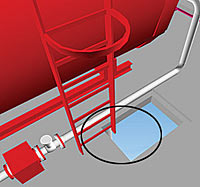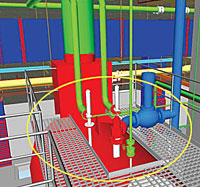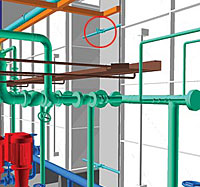Transformative Tools Start to Take Hold
Although the official GSA goals may seem relatively modest, agency administrators predict the requirements will serve to demonstrate the power of the technology and encourage more comprehensive deployment. "Any team that uses BIM to perform spatial management is unlikely to return to the old technology," says Charles Matta, FAIA, director of the GSA's Center for Federal Buildings and Modernization.
|
||
The increasing body of well-advanced and completed projects should also serve to broaden the industry's adoption of BIM as team members promote the benefits of the process. One recently completed project that used BIM comprehensively is a 65,000-square-foot, three-story office building in Houston designed by Kirksey. Although the firm had been using ArchiCAD, Graphisoft's object-based software since the late 1990s, this was its first experience as part of an integrated design and construction team using BIM, says Russell Wooten, Kirksey associate. On earlier projects, the firm's consultants had always worked in 2D.
The model was used to evaluate glazing options, perform daylight studies and energy analysis, and coordinate the structural, m/e/p, and architectural systems early in the construction document phase. The general contractor and owner of the building, Satterfield & Pontikes, used the model as an estimating and scheduling tool. The LEED Gold−rated facility was designed and built in 11 months, with no Requests for Information. Use of BIM helped shave two months from the construction schedule and also saved about $10 to $15 per square foot, estimates George Pontikes, Satterfield & Pontikes president and C.E.O.
|
||||||
Helping NBBJ meet an aggressive design and construction schedule was one of many reasons for using BIM on the Glickman Pavilion, a 325,000-square-foot urology, nephrology, and dialysis center at the Cleveland Clinic in Cleveland. Although programming was begun in the summer of 2005, more than a year after construction of an adjacent cardiac center was started, the hospital targeted October 2008 for completion of both buildings. "The promise of finding efficiencies [in BIM] has always been there, but we've seen it demonstrated for the first time on this project," says Doug Parris, AIA, NBBJ project manager and partner.
When the owner added another elevator to the building after the contractor had started construction of the foundations, the architect was able to update the model in less than half a day. Construction has progressed smoothly, with structure for five of the building's 10 floors complete and installation of the curtain wall under way. "Fast-track projects are done all the time, but we were able to do it here without extra staffing," says Parris.
One huge benefit of using BIM for systems-intense building types such as hospitals is the capability of detecting conflicts between the m/e/p components and the architectural and structural elements. A health-and-safety review of the combined digital model for the Royal Hospital London, a 912-bed facility designed by HOK and slated for completion in 2012, uncovered several potential hazards and maintenance issues. Problems such as inaccessible valves and a service ladder located too close to a manhole would have been costly to correct had they not been detected before construction, points out Miles Walker, a HOK vice president and London office CAD manager. He adds that the kind of intelligence embedded within the model will also be useful once the building is in operation as part of the facility management system.













